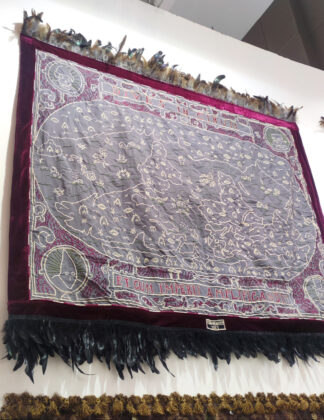Christmas Concert at The Pen features the MSO
From favorite carols to music from movie musicals, The Peninsula Manila’s annual Christmas concert shines a spotlight on the talents of the Manila Symphony Orchestra (MSO), Lara Maigue, Arman Ferrer, and the Ateneo Chamber Singers under the baton of National Artist for Music Ryan Cayabyab. The concert will be on Dec. 3, 5 p.m., at the hotel’s famed Lobby. Musical theater performers and Aliw awardees Lara Maigue and Arman Ferrer are the featured solo guest artists this year. Under the direction of Floy Quintos and musical director and conductor Mr. Cayabyab, this year’s annual festive season concert promises to ring in the Christmas spirit with favorite carols and orchestral pieces from musical theater and the classics. Joining Ms. Maigue, Mr. Ferrer, the MSO, and Mr. Cayabyab are the Ateneo de Manila University’s Ateneo Chamber Singers and the Kalilayan Folk Dance Group. The first part of this year’s concert includes music from E.T.: The Extra Terrestrial, My Fair Lady, West Side Story, and Camelot, as well as a Michel Legrand medley, and traditional Christmas carols. There is a P60,000 consumable fee for a table of 10 (with a set festive merienda) or P24,000 for a table of four (with a set festive merienda menu) at The Lobby. Tables of four are available at The Upper Lobby for P14,000. For inquiries on the Christmas Concert at The Pen 2023, call 8887-2888, extension 7410 (Festive Desk), e-mail diningpmn@peninsula.com, or visit the website peninsula.com.
‘Gathering Point’ at ARTablado Galleria
The term “gathering point” can mean a meeting place, a stomping ground or a hangout. For four friends who hail from Angono, it’s the title of their ongoing group show at ARTablado at Robinsons Galleria as well as a reunion and a chance for them to showcase their artistry. Jovito Andres, Edberth Roan, William Ner, and Irwin Tolentino all grew up in the town of Angono, a place that has cultivated dozens of artists and creatives. The four were mentored by Angono native and visual artist Nemi Miranda who is credited with the art style called Imaginative Figurism. All four went on to develop their respective art styles. Mr. Andres, who has remained in Angono, honed a style of painting that hews to traditional Filipino values of family. Using oil paints on canvas or wood panels, or pastels on paper, his idealized depictions include a family unit as well as separate paintings of Mother and child, and a Father and child. Mr. Roan works with charcoal or colored pencils to create drawings of orchids, lily pads and water lilies seen from above, and koi. He also works with mixed media using metalwork, gilded fibers, and everyday objects. Mr. Ner uses oil paints on Masonite board or canvas to create realistic and surreal paintings that incorporate disparate elements like Lego bricks, a Pinocchio puppet, bunched-up fabric, and tiny storm clouds. Mr. Tolentino, creates abstract expressionist pieces with acrylic paints and ink on watercolor paper. The exhibit runs until Nov. 30.
MO_Space presents portrait show
Mo_Space presents “A Portrait of a Portrait Show (Part 1),” a group exhibit curated by Elaine Roberto Navas featuring portraits created by 60 artists. On view will be the works of Poklong Anading, Allan Balisi, Nice Buenaventura, Lyle Buencamino, Zean Cabangis, Bea Camacho, Lena Cobangbang, Louie Cordero, Idan Cruz, Jigger Cruz, Kiri Dalena, Leslie De Chavez, Kawayan De Guia, Dina Gadia, Nona Garcia, Gregory Halili, Robert Langenegger, Cocoy Lumbao, Pow Martinez, Wawi Navarroza, Gary-Ross Pastrana, Patricia Perez Eustaquio, Erwin Romulo, Carina Santos, Isabel Santos, Luis Antonio Santos, MM Yu, Alvin Zafra and Costantino Zicarelli. The exhibit opens on Nov. 25 and will run until Dec. 31. A Portrait of a Portrait Show attempts to explore both methods in dealing with the idea of the “portrait.” By showing works of 60 contemporary Filipino artists, the exhibition becomes a multifaceted compendium on new ways to interpret the genre of portraiture, as well as in becoming its own portrait and survey through a gathering of different art practices. The gallery, located at Bonifacio High Street in BGGC, Taguig, is open daily from 10 a.m. to 7 p.m.
Art conservation class at The M
The Metropolitan Museum presents Art Conversation 1: Restoring old documents, maps, and artworks on paper with art conservator and educator Eddie Jose. The class is free and open to the public. It will be held on Nov. 25, 1:30 to 4:30 p.m. at the Metropolitan Museum of Manila. To join the class register at bit.ly/3suxePI. This is the first in new series of in-depth conversations on art conservation hosted by the Metropolitan Museum of Manila, in partnership with the De La Salle University-Dasmariñas Center for Heritage Conservation. The Metropolitan Museum of Manila is located at the Mariano K. Tan Centre, 30th St., Bonifacio Global City, Taguig City. For more information call 8361-1488, 0917-160-9667, or e-mail info@metmuseummanila.org.
Korean Cultural Center joins BGC’s Passionfest
The Korean Cultural Center (KCC) is joining this year’s Passionfest, collaborating with Bonifacio Global City (BGC) to present the GLOCAL: Color & Culture Festival on Nov. 25-26, at Bonifacio High Street. TAGO, a dynamic percussion performance group established in 2015, will add its unique rhythm to the parade along 5th Ave. on Nov. 25 and will have a performance on Nov. 26. As part of the festival’s immersive experience, the KCC invites all attendees to a free two-day interactive booth. Discover the traditional art of nail dyeing using flower, known as Bongseonhwa. Delve into the cultural significance of this red flower, historically planted to ward off evil spirits. The booth will be open from 10 a.m. to 5 p.m.
PHL Suzuki Youth Orchestra holds holiday concert
Christmas carols are the focus on the concert Joy to the World, featuring the Philippine Suzuki Youth Orchestra. It will be held at the Metropolitan Museum of Manila on Dec. 2, 3 p.m. Admission is free. The is located at the Mariano K. Tan Centre, 30th St., Bonifacio Global City, Taguig City.
Free piano concert focuses on the classics
On Dec. 2 at 6 p.m., the internationally renowned concert pianist Jordan Shangkuan Ong will be performing at the Manila Piano in Makati. He will be performing with pianist Dr. Oliver Salonga, and Chinese orchestra conductor Danny Chin. The event will be hosted by Chinatown TV. The evening’s repertoire will include Gershwin’s Rhapsody in Blue, Chopin’s Scherzo, and Rachmaninoff’s Concerto No. 2., as well as popular Chinese and Filipino folk songs. Mr. Ong comes from a prominent musical family in the Philippines that includes opera librettist Shih Chang Shangkuan, Aliw awards-winning producer Rebecca Shangkuan, international choral conductor Pearl Shangkuan, Philippines Philharmonic Orchestra guest conductor Beverly Shangkuan, many church choir directors and concert pianists. Mr. Ong has performed around the world, at many renowned venues such as the Kennedy Center in Washington D.C. and the Kimmel Center in Philadelphia. Manila Piano is at the 4/f of the Ronac Lifestyle Center, Paseo Magallanes, Makati. Tickets are free on a first come first serve basis. For ticket reservations call Melanie Ong at 0968-270-3228 or Christine de los Santos at 0917-981-7766.
CCP Met: Live in HD season ends with Cossi fan Tutti
Season 8 of The Met Opera in HD — a collaboration of the Cultural Center of the Philippines, the Metropolitan Opera of New York, the Filipinas Opera Society Foundation, Inc., and Ayala Malls Cinemas — culminates with Mozart’s Cosi Fan Tutte on Dec. 5, 5:30 p.m., at Greenbelt 3 Cinema 1 in Makati City. Part of the Met’s popular English-language holiday series, this opera is a twisted tale about two pairs of lovers who find themselves on one emotional, and sometimes literal, thrill ride after another. Tickets are priced at P450. Students and young professionals may enjoy the screenings for P100 upon presentation of a valid ID. Tickets are available at Greenbelt ticket booths and on the website www.sureseats.com.
BP, Pintô Art Museum collaborate on a holiday art exhibit
Ballet Philippines (BP) and Pintô Art Museum have partnered for a special art exhibit featuring the work of 35 contemporary Filipino artists. The exhibit, titled “Ballet in Pintô,” will premier on the gala night of Ballet Philippines’ Christmas Fairytales on Dec. 15. The lobby of The Theatre at Solaire will be transformed into an art space where visual arts and dance meet. Pintô Founder Dr. Joven Cuanang and artist/curator Ferdie Montemayor commissioned 35 contemporary Filipino artists to produce paintings and sculptures that will feature the company’s dancers. Last July, Pintô invited the Ballet Philippines dancers to the museum’s Academy Room for a special day of art and dance. The afternoon provided the artists an opportunity to meet and study their subjects. As the dancers performed excerpts from Christmas Fairytales, the artists made studies for their eventual works. The finished works will be on exhibit from Dec. 15 to 17, during Ballet Philippine’s performances of Christmas Fairytales. The proceeds earned from the upcoming exhibition will benefit the causes supported by the Pintō Museum and Ballet Philippines.
Geraldine Javier shows at Silverlens
Geraldine Javier’s exhibit, “A Tree is Not a Forest” is now on view at Silverlens until Dec. 20. How are important discoveries in the natural sciences relevant to our current environmental concerns? The artist responds to this question with a plethora of mediums and techniques, and the potential of flora as collaborator in storytelling. Javier presents five series in this exhibit: Portraits of Four Important Naturalists, What’s in a Name?, Life Cycle series, Humans as Predators, and New Species in an Anthropocene Era. She employs techniques both old and new — embroidery, cyanotype printing, ecoprinting, and mordanting, among others. Silverlens is located at 2263 Don Chino Roces Ave. Ext., Makati City.
PETA holding auditions for musical
The Philippine Educational Theater Association’s (PETA) production for 2024, One More Chance, the Musical, featuring the music of the popular Filipino nine-piece band, Ben&Ben, announces the casting call for auditions starting Monday, Nov. 20. Applicants must submit 16 bars, or one stanza and one chorus, of the best part of any Ben&Ben or OPM song, along with four bars of choreography to any contemporary modern music. The full set of requirements can be found at this link: https://tinyurl.com/OMCauds. The deadline for all casting submissions will be Nov. 26 at 11:59 p.m. Live auditions at the PETA Theater Center will follow from Dec. 4 and 5. One More Chance, the Musical is slated to open in April 2024 at the PETA Theater Center. For more information, follow PETA Theater on Facebook, Instagram, Twitter, and TikTok.
Araneta City’s traditional belen up for the holidays
Araneta City lit up its annual giant belen display on Nov. 17. Located at Gen. MacArthur Ave., the life-sized nativity scene, features images of the infant Jesus, Mary, Joseph, and the three kings. It is a holiday tradition observed by Araneta City since 1991. The lighting of the belen is part of the many Christmas events and activities in Araneta City this year under the theme “City of Firsts, Your Home This Christmas.” Other traditional Christmas attractions at the Quezon City commercial area include the Parolan bazaar, where one can find quality and affordable Christmas decorations; the Times Square Park for a cool al fresco dining with an up-close view of the Giant Christmas tree; the Grand Fireworks Display on Fridays to Sundays at 7 p.m.; and the Santa Claus and friends meet-and-greet and parade at Araneta City malls every weekend.





















